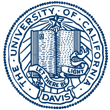
This REU program was funded through NSF PHY-1560482.
Students' names link to their final papers. Advisors' names link to the research group web pages.
Astrophysics
Nathaniel MacFadden (Reed College; advisors Tony Tyson and Mani Tripathi) performed numerical simulations of time-dependent electric fields inside of a shielded room to determine the antenna factor for an experiment to detect dark photons. Astronomical observations have provided abundant evidence for the presence of dark matter, a substance that experiences gravitational attraction but has little or no electromagnetic interactions. Multiple theories have been advanced to propose different dark matter candidates, and experiments are underway around the world to detect dark matter particles. One class of theories, however, postulates that dark matter is best described as a massive photon. As a consequence, dark photon fields may be omnipresent, and depending on the coupling to ordinary electromagnetic fields, the dark photon field may be detectable. Nathaniel performed detailed calculations to quantify the size of a detected field for an ongoing experiment in operation in Davis. The image of modes in a waveguide just below is from his work.
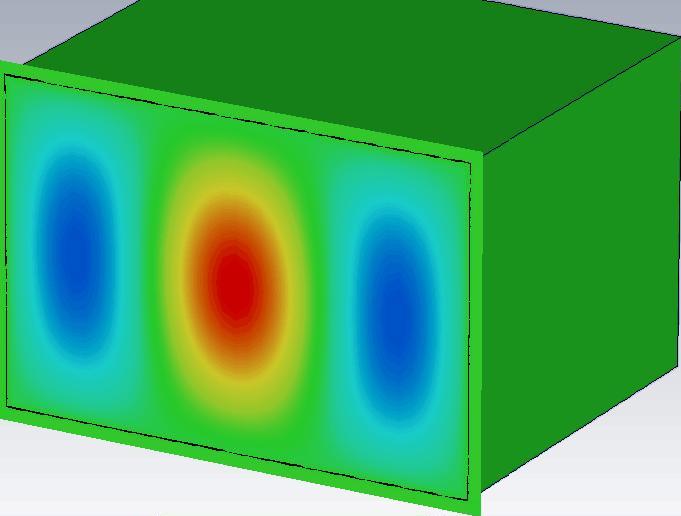
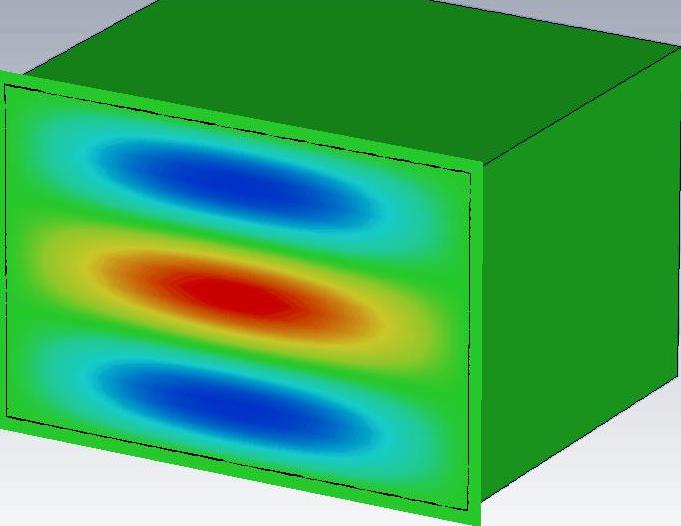
The cosmic microwave background (CMB) gives outer space its temperature of 2.7 Kelvin. The CMB amplitude is nearly independent of the measurement direction, but variations on the order of 20 microKelvin have provided a great deal of information on the early universe. Another slight non-uniformity in the CMB is that the radiation has a partial linear polarization. The way this polarization varies with position could come from ancient gravitational waves, although unfortunately much more mundane dust effects from our galaxy can look similar. Moutaz Haq (University of Texas at Dallas; advisor Lloyd Knox) trained a neural network to recognize dust-heavy images. Our restriction to a single physical universe limits the size of the training set, so real images were supplemented by simulated pictures with dust contamination. The method is promising, but further work is needed to ensure that the simulated and physical dust images match in a variety of statistical tests.
Mackenzie Joy (University of Georgia; advisor Lloyd Knox) investigated a discrepancy between theoretical and observational values for the cosmological sound horizon. Local mass fluctuations in the very early universe produced spherical waves, the cosmological "sound." As the universe cooled, photons decoupled from matter, so the light we observe from a given sound wave corresponds to a shell of matter of some particular size. These sizes vary, but a statistical analysis can extract the typical value. Since even the data analysis requires some modelling, Mackenzie ran Monte Carlo simulations to extract sound horizon values from observations. Her results show significantly smaller values than do calculations based on the theoretical standard model of cosmology. The standard model itself also has parameters determined from observational input, but these come from different measurements that have undergone many other consistency checks. The current discrepancy could signal an extra contribution to the expansion of the early universe, perhaps from an extra neutrino species.
Mario Autore (George Mason University; advisor Matt Richter) ran simulations of a possible space-based spectrometer that could search for specific molecules in the atmosphere of other planets. The molecules chosen could indicate life. Given the great expense of space-based measurements, potential funders must be convinced of their feasibility well in advance. Mario generated spectra representing plausible signals from a potentially habitable planet and its star. Since the star's signal exceeds that of the planet by many orders of magnitude, he averaged it away to reveal the planetary spectrum. Further analysis could identify molecules present in the planet's atmosphere.
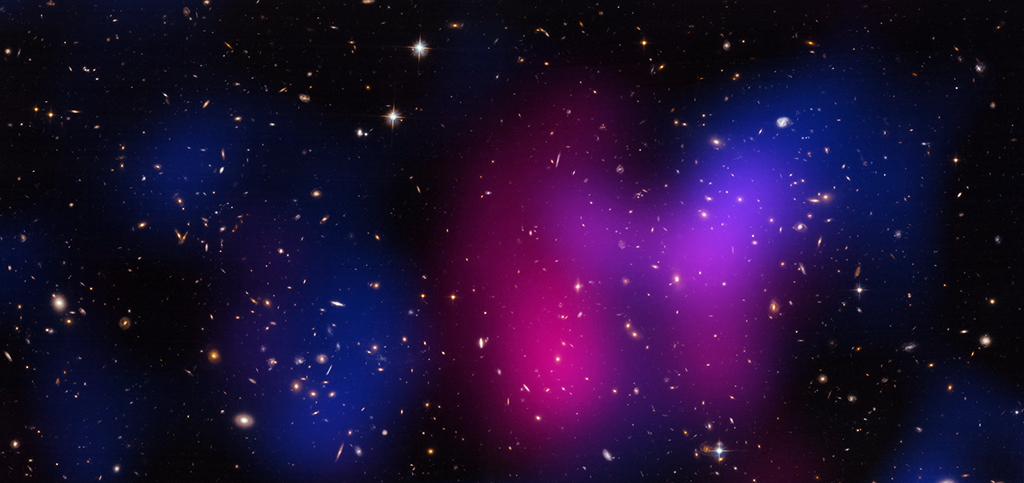
In astronomy research, we observe only a snapshot of what a particular galaxy or other object is doing. Other galaxies may be in the midst of a different stage of the same phenomenon, but matching these up to understand the dynamics is not easy. One approach is to generate a possible universe through a computer simulation and compare its statistical properties at a fixed time with our observations of the physical universe. Even with such a simulation, there remains the problem of matching some physical object with those in the simulation that behave similarly. Livia Darmawan (Skyline Community College; advisor David Wittman) mined a large simulation for colliding galaxy clusters, in order to estimate the closest approach of real galaxy clusters during their collisions. She developed a parabolic interpolation to compensate for the calculation's limited time resolution. This is a step towards better understanding collisions of galaxy clusters and their implications for dark matter.
Condensed Matter Experiment
Valerie Gugliada (Ithaca College; advisor Shirley Chiang) studied gold atoms deposited on the surface of germanium. The gold forms a single atomic layer and then clusters into three-dimensional structures, which can move and reform as temperature changes. This behavior had been previously observed using a low-energy electron microscope. Valerie worked on setting up similar measurements with a scanning tunneling microscope (STM), which has better spatial resolution. Her work involved setting up microscope tips and fixing problems with the vaccum chamber, sample holder, and heating circuits. She achieved initial STM images just before the summer ended.
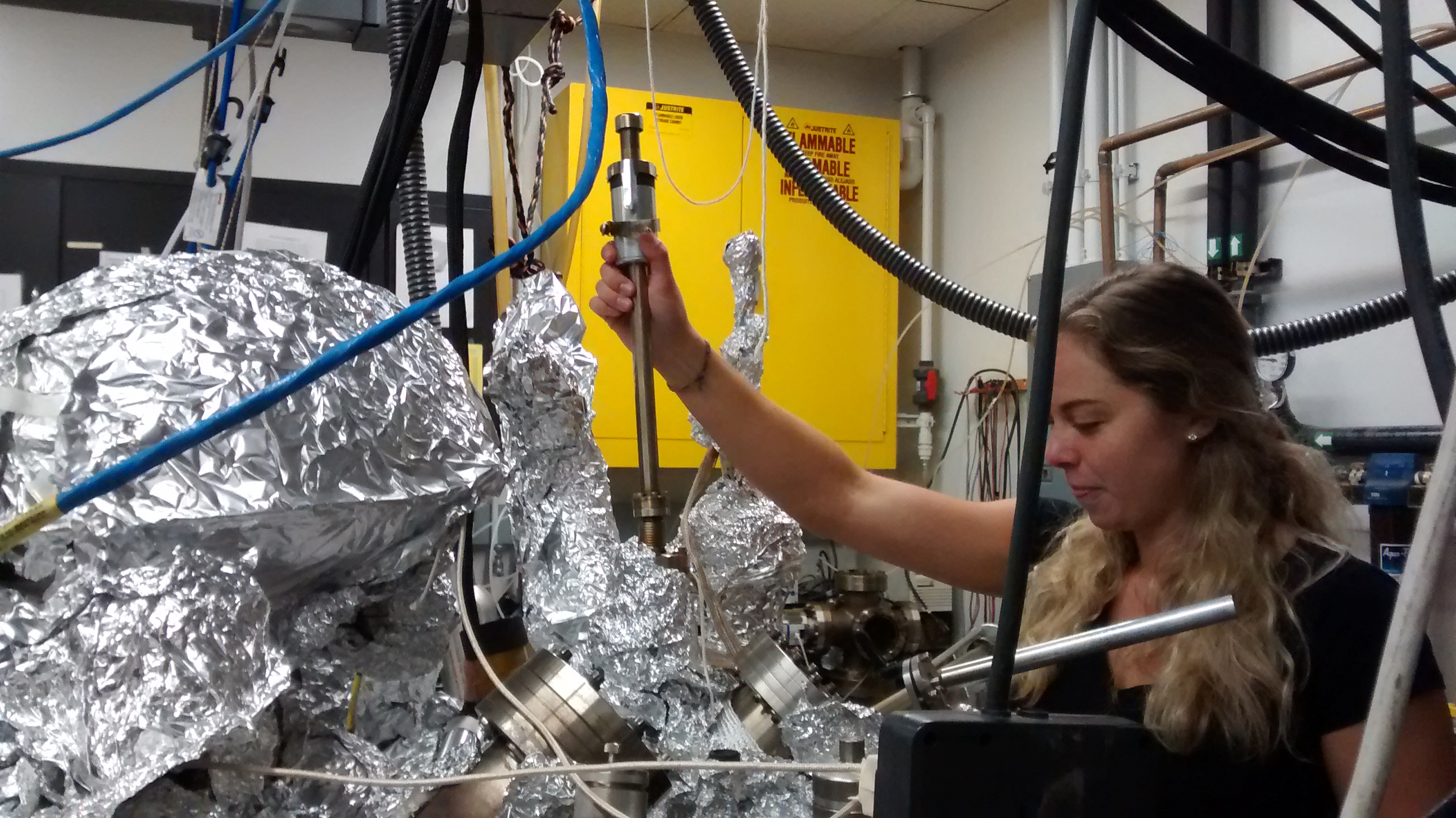
Stephania Ortiz (CSU San Bernardino; advisor Rena Zieve) worked on the data analysis software for an artificial sandpile setup. The pile consists of ball bearings confined to a two-dimensional vertical layer. Slowly rotating the layer within its vertical plane leads to isolated avalanches, which can be filmed and analyzed. Stephania found and fixed several problems with the code. Among these, an initial algorithm to identify ball locations had trouble with the outside edge of the container and located some "balls" that are not even within the container. Another problem came when the brightest reflections on neighboring balls were too close together. A simple reduction of the distance threshold created a different issue with a single ball being counted twice. Once the code is fully functional, it will be used to understand how the detailed arrangment of the balls within the pile gives rise to the observed avalanche angles.
Moira Miller (Virginia Tech; advisor Valentin Taufour) Moira Miller (Virginia Tech, advisor Valentin Taufour) synthesized and characterized single crystal samples of a new Weyl semimetal compound, Hf2Te2P, which has an unusual behavior of the electronic dispersion. Large single crystals were grown using chemical vapor transport, and then characterized by x-ray scattering to investigate the lattice constants as a function of doping. Further measurements of the magnetization at low temperatures as a function of field revealed small variations, known as quantum oscillations or the de Haas-van Alphen effect. These oscillations provide important information about the Fermi surface in this material. The best single crystals were then selected for more specialized experiments, including scanning tunnelling microscopy and angle-resolved photoemission spectroscopy measurements.

Superfluid helium exhibits many counterintuitive behaviors, from zero-viscosity fluid flow to cessation of boiling. One of the strangest is that circular fluid flow is quantized, with only certain discrete patterns possible. This allows a clear definition of a vortex as the line running down the center of a circulating flow. Josephine Spiegelberg (Rollins College; advisor Rena Zieve) worked on exciting waves along a superfluid vortex by shaking one end of the vortex, much as one can excite waves on a rope by shaking one end while the other is tied in place. She found that vigorous excitation can produce at least the two lowest modes of vibration of the vortex, and that the amplitude of the waves changes dramatically as the drive level increases. This may signify the onset of wave turbulence along the vortex; future measurements will explore this possibility.
Jalan Ziyad (Reed College; advisor Nicholas Curro) used his strong computer background to tie together various separate data acquisition software into a single coherent program with a user-friendly front end. The new software controls magnetic resonance measurements of nitrogen-vacancy centers in diamond. Jalan's outer layer of software includes threading, a way of allowing the computer to multi-task by running several processes at once. He paid special attention to setting priorities, for example making sure that different processes would not try to change a variable simultaneously. Now that the backbone of the system is in place, other improvements are possible, such as using an automated pulse from the experiment's excitation laser rather than a steady beam.

Harry Fetsch (Harvey Mudd College; advisor Dong Yu) measured the transport properties of nanowires of a topological insulator, Bi2Se3. After growing the nanowires using chemical vapor transport, the nanowires were transferred to a silicon substrate with a thin insulating silicon oxide layer. Using lithographic techniques, electrodes are deposited on a single nanowire for a series of transport measurements as a function of the gate voltage applied to the silicon substrate. Furthermore, a laser is focused and scanned over the nanowire to create photoexcited carriers in order to map the photocurrent profile. (The wire shown just above is about 450 microns long.) These measurements enable one to measure the mobility of the carriers and their decay length. The results indicated that the carriers are charge neutral excitons - pairs of excited electrons and holes. The large mobility and transport lengths suggest that the excitons may be forming a Bose-Einstein condensate at temperatures greater than 77K.
David Chaparro (University of Texas; advisor Nicholas Curro) performed optically-detected magnetic resonance (ODMR) experiments of nitrogen-vacancy centers in diamond. NV centers are atomic defects in the diamond lattice that have a net electron spin which can be manipulated with microwave pulses. The defect is also fluorescent, and the intensity of the fluorescence depends on the direction of the spin. By measuring the fluorescence intensity as a function of microwave irradiation frequency, one can measure the local magnetic field at the NV site. This technique thus offers a unique opportunity to measure magnetic behaviors at high pressures in a diamond anvil cell. Because the diamond anvils are transparent to light, one can perform ODMR under pressure to measure magnetization, whereas conventional magnetization measurements cannot operate under these conditions. David's work focused on optimizing conditions for ODMR in a diamond anvil cell.

Condensed Matter Theory
Foster Thompson (Case Western Reserve University; advisor Rajiv Singh) did numerical calculations of a two-dimensional Ising spin system. These are spin-1/2 particles, arranged in a square lattice and restricted to point along the axis perpendicular to the lattice. An interaction between neighboring particles favors parallel alignment. In the ideal system, ordering sets in below a finite transition temperature where all the spins align in the same direction. Foster's calculation had two additional features: site dilution, where the spins are missing from some sites, and an in-plane magnetic field. Both of these tend to decrease the ordering temperature. Unusual effects can happen when spins are removed from some sites at random. There may be regions with no missing spins, where the local ordering temperature is higher than that of the full system. In some cases these regions can give outsized contributions to the system's behavior, known as Griffiths-McCoy singularities. Foster found numerical evidence of this phenomenon in his zero-temperature calculations.
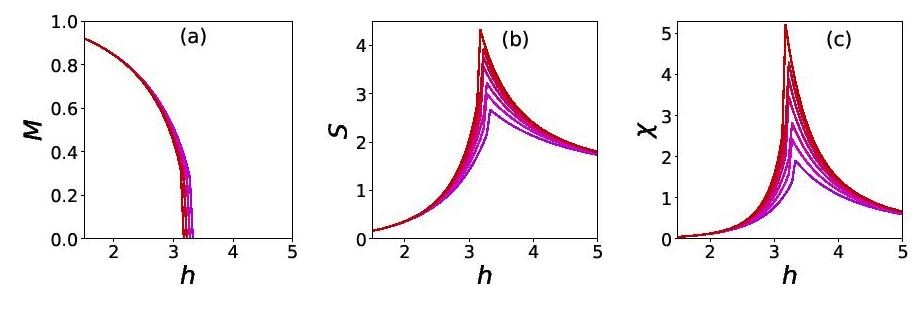
Nuclear Experiment
Head-on collisions between high-energy Pb ions can create a quark-gluon plasma (QGP). However, teasing out the effects of the plasma requires an excellent understanding of other nuclear interactions that occur. Ariana Caiati (Moravian College; advisors Daniel Cebra and Manuel Calderon de la Barca Sanchez) calculated the expected number of nucleon collisions in such an event, relating it both to the offset between the colliding ions and to experimental measurements of the kinetic energy perpendicular to the collision direction. When the offset is large, fewer nucleons collide and the QGP is less likely to occur. Analyzing data as a function of the offset will be helpful for disentangling QGP physics from other nuclear phenomena.
Particle Experiment

Sean Conlon (Santa Rosa Junior College; advisor Bob Svoboda) worked on calibration of the liquid argon neutrino detector for the Deep Underground Neutrino Experiment (DUNE). The signature of a neutrino interaction ultimately comes from electrons, which are guided by an electric field to a wire grid detector. The vast size of the argon bath means that electric field non-uniformities can make signals from different parts of the bath vary. Hence the calibration needs to take into account the location of the event within the argon bath. Ideally this can be done externally. Sean simulated how an external neutron source would perform in the setup illustrated just above. He found that it is indeed a viable path, and he optimized dimensions for particular source materials. The next step will be constructing and testing a neutron source.
See also Nathaniel MacFadden's project involving both Astrophysics and Particle Experiment.